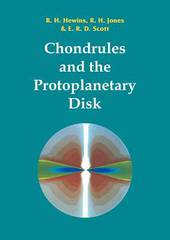
|
Chondrules and the Protoplanetary Disk
Paperback / softback
Main Details
| Title |
Chondrules and the Protoplanetary Disk
|
| Authors and Contributors |
Edited by R. H. Hewins
|
|
Edited by Rhian Jones
|
|
Edited by Ed Scott
|
| Physical Properties |
| Format:Paperback / softback | | Pages:362 | | Dimensions(mm): Height 297,Width 210 |
|
| Category/Genre | Solar system |
|---|
| ISBN/Barcode |
9780521174893
|
| Classifications | Dewey:523.5 523.51 |
|---|
| Audience | | Professional & Vocational | |
|---|
| Illustrations |
Worked examples or Exercises
|
|
Publishing Details |
| Publisher |
Cambridge University Press
|
| Imprint |
Cambridge University Press
|
| Publication Date |
3 March 2011 |
| Publication Country |
United Kingdom
|
Description
Chondrules in primitive meteorites have excited and challenged scientists since they were first described nearly 200 years ago. Chondrules were made by some pervasive process in the early solar system that formed melted silicate droplets. This 1996 text was the first comprehensive review of chondrules and their origins since a consensus developed that they were made in the disk of gas and solids that formed the Sun and planets 4.5 billion years ago. Fifty scientists from assorted disciplines have collaborated to review how chondrules could have formed in the protoplanetary disk. When and where in the disk did they form? What were they made from and how fast were they heated and cooled? What provided the energy to melt chondrules - nebular shock waves, lightning discharges, protostellar jets? Following an exciting international conference in Albuquerque, New Mexico, the latest answers to these questions are presented in thirty-four articles.
ReviewsReview of the hardback: ' ... an excellent tutorial on current thinking about the formation of chondrules and their relation to the solar nebula.' Harry Y. McSween Jr., Science Review of the hardback: 'It is a comprehensive overview, complete with a glossary. The extensive colour images, figures, explanatory boxes and lists of keywords make for a very lively appearance.' Sue Bowler, Astronomy & Geophysics
|